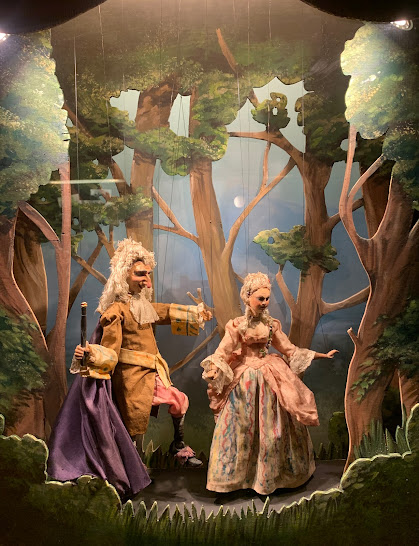While in Salzburg, Austria, I was able to visit two different sites that have examples of marionette puppetry from the region, the Marionette Museum in the Hohensalzburg Fortress and The Salzburg Marionette Theatre.
Salzburg Marionette Theatre
The first place that I visited was the Salzburg Marionette Theatre. The performance technique used at this theatre is considered a UNESCO intangible cultural heritage. The theatre was established in 1913 by Anton Aicher.
When you first walk into the lobby of the theatre you are greeted by marionettes lining the walls and displays that show vignettes of stories as well as the design and build process of the puppets.
"The tradition of the Salzburg Marionettes is based on constant innovation, outstanding productions and the almost human appeal of the marionettes."
Costumes by Marie Luise Walek from "The Gardener's Love"
All of the costumes are made by an in-house workshop at the Salzburg Marionette Theatre
 |
| Puppet designs for various shows including Alice in Wonderland and The Sound of Music |
 |
| Process of the puppet build with specifications for how it goes together |
 |
| Patterning for the puppet's clothing, as well as various puppet body parts |
 |
| The process of how the puppet is assembled, painted and the various fabric swatches to create the garments. |
 |
| The final puppet |
Historical Artifacts of the Salzburg Marionette Theatre
Stage design by Gunther Schneider-Siemssen
He designed for the Salzburg Marionette Theatre from 1951-1991.
Negative plates with scenes from early shows like The Stork (1916) and The Knowing Animals (1916)
Vignette from Bastien and Bastienne (by Mozart) which was the first production performed by the Salzburg Marionette Theatre in 1913.
Colas doll head by Anton Aicher, Bastienne doll head by Karl Aicher, and costumes by Rosa Aicher
The performance that I saw at the Salzburg Marionette Theatre was the opera by Mozart, The Magic Flute. This was a great choice of show to see because of the fantastical nature of the story and production what translated well into puppetry. The show began by revealing the backstage workshop. As the prelude began for the opera, you could see the puppeteers setting the stage, arranging the back drop and getting the puppets into place. It was magical to see the elements coming together before the show began.
Pre-show set up of the backstage before the performance began.
The show itself was a great performance. The opera was prerecorded, but the puppets made the story come to life. Each puppet was performed with incredible skill, showing nuance in the head and hand gestures. The performance was also very dynamic in how the characters moved across the stage, whether it was the Queen of the Night flying through the air or Papageno jumping from limb to limb on a tree. Within the show there was use of both smoke and real flame, making the performance feel even more real. Each scene was transformed with a new set and the puppets continued to engage the audience for the two hours and thirty minutes of the show.
The second marionette display in Salzburg is at the Hohensalzburg Fortress. This museum is located in the Prince's Cellars within the center of the castle. Inside the museum are several displays and vignettes. These marionettes are from the historic collection of the Salzburg Marionette Theatre as well.
 |
| Little Devil from "The Wizard of Oz" (1952) |
 |
| A vignette of "Mozart's Home" showing Mozart and his parents traveling. |






































































